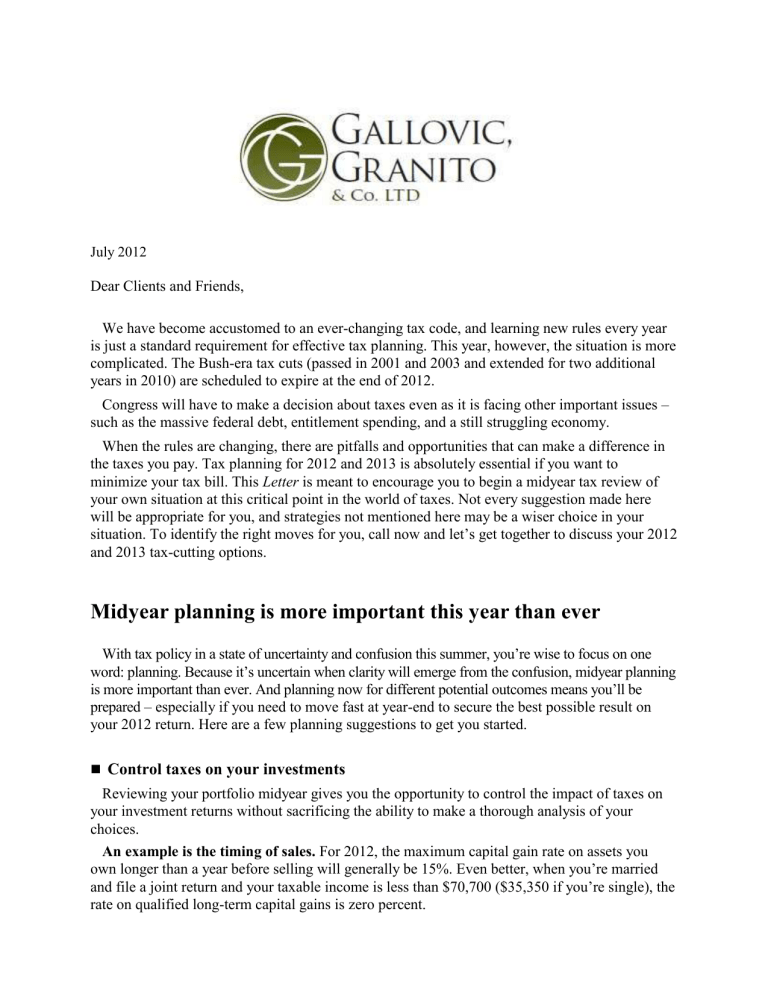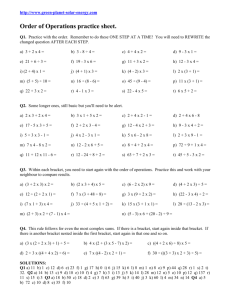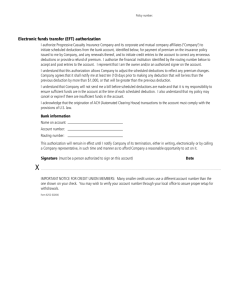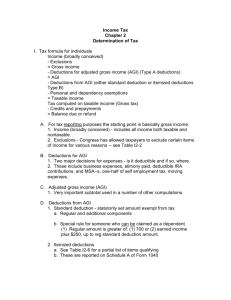July Newsletter 2012 - Gallovic, Granito & Co. Ltd.

July 2012
Dear Clients and Friends,
We have become accustomed to an ever-changing tax code, and learning new rules every year is just a standard requirement for effective tax planning. This year, however, the situation is more complicated. The Bush-era tax cuts (passed in 2001 and 2003 and extended for two additional years in 2010) are scheduled to expire at the end of 2012.
Congress will have to make a decision about taxes even as it is facing other important issues – such as the massive federal debt, entitlement spending, and a still struggling economy.
When the rules are changing, there are pitfalls and opportunities that can make a difference in the taxes you pay. Tax planning for 2012 and 2013 is absolutely essential if you want to minimize your tax bill. This Letter is meant to encourage you to begin a midyear tax review of your own situation at this critical point in the world of taxes. Not every suggestion made here will be appropriate for you, and strategies not mentioned here may be a wiser choice in your situation. To identify the right moves for you, call now and let’s get together to discuss your 2012 and 2013 tax-cutting options.
Midyear planning is more important this year than ever
With tax policy in a state of uncertainty and confusion this summer, you’re wise to focus on one word: planning. Because it’s uncertain when clarity will emerge from the confusion, midyear planning is more important than ever. And planning now for different potential outcomes means you’ll be prepared – especially if you need to move fast at year-end to secure the best possible result on your 2012 return. Here are a few planning suggestions to get you started.
Control taxes on your investments
Reviewing your portfolio midyear gives you the opportunity to control the impact of taxes on your investment returns without sacrificing the ability to make a thorough analysis of your choices.
An example is the timing of sales.
For 2012, the maximum capital gain rate on assets you own longer than a year before selling will generally be 15%. Even better, when you’re married and file a joint return and your taxable income is less than $70,700 ($35,350 if you’re single), the rate on qualified long-term capital gains is zero percent.
If you expect rates to rise in 2013, it may make sense to harvest gains before year-end.
Remember, wash sale rules do not apply to gains, so you can repurchase a similar investment immediately. This tactic may allow you to “reset” your basis for a future sale while benefiting from current low rates.
What if you have investment losses?
Despite the uncertainty over a possible increase in tax rates, it’s a good bet that some rules – such as those covering capital losses – will not change.
When pruning stocks from your portfolio, keep in mind that capital losses are more valuable when tax rates are higher. You may want to postpone taking losses until 2013 if you think rates will be higher next year.
Other investment areas to review for potential tax savings include allocations between retirement accounts and accounts generating currently taxable income, investments in dividend- paying stocks, and purchases of tax-exempt municipal bonds.
Manage your tax bracket
Are you making maximum contributions to your retirement plans?
In addition to playing a role in tax-efficient investing, adding pre-tax money to retirement accounts is one strategy for managing your tax bracket. As you know, increasing the amount you invest in your 401(k) or other plans reduces taxable income, which in turn affects the tax bracket applicable to that income.
The maximum contribution you can make to your 401(k) in 2012 is $17,000. You can add
$5,500 to that if you’re age 50 or older. For Roth and traditional IRAs, the limit for 2012 is
$5,000 and the maximum additional catch-up contribution is $1,000.
Managing your bracket is also useful if you’re considering converting a traditional IRA to a
Roth. Because the amount you convert is taxable at ordinary rates, it may make sense to shift just enough this year to take you to the top of the lowest possible marginal tax bracket.
Another situation where keeping an eye on your bracket can be a tax-smart move: if you made a Roth conversion back in 2010 and chose to defer recognizing part of the income until this year.
Time your deductions for maximum benefit
Getting the most benefit from tax deductions requires multi-year planning as well as consideration of the alternative minimum tax (AMT).
The multi-year part involves “bunching” your expenses. That’s a strategy where you decide to accelerate or delay payments between different years for itemized deductions such as state income taxes, routine health care, and charitable contributions. You calculate the tax savings for each year and choose the most advantageous time to pay the expense and claim the deduction.
The AMT adds another step to the calculation because it eliminates certain deductions. For instance, state and local income taxes are not deductible when figuring AMT liability.
What if you usually claim the standard deduction?
You’ll still want to take a look at your total itemized deductions in case you’re close enough to the tipping point to consider accelerating some expenses into 2012. In addition, there are circumstances where itemizing makes sense even when the total is lower than your standard deduction. Your exposure to the AMT can come into play here, too, since the standard deduction is not allowed in the AMT calculation.
2
For 2012, the regular standard deduction when you’re married filing jointly is $11,900 ($5,950 for singles). Midyear planning gives you time to budget for additional current-year payments for itemized deductions and other expenses, such as qualified tuition, that can garner benefits this year and next.
What’s scheduled to expire after 2012?
Here’s a quick review of the major tax changes that have occurred or that are scheduled to occur after 2012.
Bush-era tax cuts
Among the provisions set to expire at the end of 2012:
Income tax rates that currently run from 10% to 35% will go from 15% to 39.6%.
Current capital gain tax rate of 15% will increase to 20%.
Maximum rate on dividends will increase from 15% to 39.6%.
Marriage penalty will increase.
Itemized deductions and personal exemptions will again be limited for higher-income taxpayers.
Education tax breaks will expire or be reduced.
The child tax credit, currently at $1,000 per child, will be reduced to $500.
The estate tax exemption, currently at $5,120,000, will be reduced to $1 million. Current top tax rate of 35% will increase to 55%.
Payroll tax cut
The 2% payroll tax cut for employees ends after 2012.
Tax extenders
Among the extenders that expired at the end of 2011:
Optional deduction of state and local sales taxes.
$250 teachers’ deduction for purchasing supplies.
R&D tax credit for businesses.
Up to $4,000 deduction for higher-education expenses.
Tax-free contributions from IRAs to charity.
3
How much are tax savings worth to your business?
As a business owner, improving the “bottom line” is probably something you think about quite often. An increase in sales usually means an increase in profits, and so does a reduction in costs.
But did you know that cutting the tax on your business income could have the biggest financial impact of all?
It’s true: A dollar of tax saved often has more impact on your bottom line than a dollar of additional sales or a dollar of reduced costs. To understand why, remember that when you cut your taxes, you get to keep 100% of the savings.
On the other hand, when you increase sales, you must share a portion of your additional profit with the IRS. The same goes for cost savings. Since cost savings ultimately boost your bottom line, the IRS also gets its share.
If you’re still not convinced, consider this simple example. Company Z is in the 25% income tax bracket, and it operates at a 20% pre-tax profit margin. Therefore, if Company Z generates an additional $10,000 of sales, its pre-tax profit will increase by $2,000 (20% x $10,000). Of this amount, 25% or $500 must be paid out in taxes, leaving Company Z with $1,500 of additional after-tax profit.
But if Company Z could simply manage to save $1,500 in taxes, the entire amount of tax savings would flow to its bottom line. There’s another way of looking at this. For Company Z, every $1,500 of tax savings is equivalent to $10,000 of increased sales.
If your company operates at a low profit margin, the relative benefit of cutting taxes is even more dramatic than for higher-margin companies. You should never overlook opportunities to increase sales or cut costs. But sometimes, tax savings can dwarf all of your other planning efforts.
How much are tax savings worth to your business? The exact answer depends on your company’s unique financial situation.
To find out what tax savings mean to your company, let us help you run the numbers. We can also help design and implement the strategies that will result in those tax savings. Give us a call while there’s still time this year to make a difference in your 2012 tax bill.
Children’s summer jobs bring questions about taxes
With the school year over, your teenager might be taking a summer job. If so, you both may have questions about taxes. Here are some of the common concerns.
If your child chooses a typical wage-paying job, he or she will soon be confronted with the task of calculating withholding allowances on Form W-4. Claiming zero allowances and thereby withholding the maximum amount is the safest option, but it might also unnecessarily tie up hard-earned cash until this year’s tax return is filed. However, claiming too many allowances, especially if the child holds multiple part-time jobs, might cause underwithholding. For help figuring the right number, try the withholding calculator at www.irs.gov
.
4
If your child decides to mow lawns or perform other tasks and be his own boss, there are a few more tax issues to consider. Such activity will likely generate taxable income, on which federal and state income taxes might be due. If net earnings are $400 or more, self-employment taxes will also be owed. These taxes can often be paid at the time that the child files a 2012 tax return, but if the income is substantial enough, estimated tax deposits might be necessary.
Being self-employed also means keeping detailed records of income and business expenses.
Encourage your teen to purchase a simple low-cost ledger book to help organize the records. And when tracking income, remind the child that tips received are not just tokens of gratitude – they are considered taxable income by the IRS.
Summer jobs can provide tax breaks for some parents. Business owners can hire their own children and deduct the wages paid to them, effectively shifting income from the parent’s higher income bracket to the child’s lower bracket. What’s more, if operating as a sole proprietor, you do not have to pay FICA taxes if your teen is under age 18 nor pay federal unemployment taxes if the child is under age 21. Just remember, the wages you pay your child must be appropriate for the services actually rendered.
Looking for a little icing on the summer employment cake? When your child receives earned income, he or she can also qualify for a Roth IRA. The lower of $5,000 or the child’s annual earned income can be contributed to a Roth by the teen, parent, or someone else.
Summer employment can be your teen’s first exposure to the real world. Help make it a taxsmart experience. If you have questions about taxes and summer jobs, give us a call.
Be aware of the kiddie tax
If you have children heading for college this fall, you might have questions about the kiddie tax, since these federal rules can apply to the unearned income of full-time students up to age 24.
Here’s a review of what you need to know.
The basics.
The kiddie tax affects how much you’ll pay on part of the investment income your child receives, such as interest or dividends. When the rules come into play, this “unearned income” is taxed using your rates.
How the tax is applied.
For 2012, the first $950 of your child’s unearned income is tax-free.
Tax is calculated on the next $950 using your child’s federal tax rate, which can be as low as
5%. Unearned income over $1,900 is taxed at your federal income tax rate when that rate is higher than your child’s.
For an 18-year-old, the kiddie tax applies when your child’s earned income – that is, money received from wages, salary, tips, commissions, and bonuses – is less than half the cost of providing necessities such as food, clothing, and shelter.
The same 50% support exception applies when your child is a full-time student and age 19 through 23.
5
Planning tip.
Consider hiring your college student in your family business. Wages are earned income and can lessen or eliminate the kiddie tax.
Still have questions about the kiddie tax? Give us a call. We have answers, information, and planning strategies.
Developing a sound tax plan from year to year is difficult enough, but responding to this year’s complicated tax law environment is especially challenging. Even so, the best tax tip remains the same: stay in touch with us. We will be monitoring legislation for changes that could affect your tax and business situation. For a midyear tax review, give us a call today.
Sincerely,
Gallovic, Granito and Co. Ltd
NOTE: This newsletter is issued at midyear to provide you with information about minimizing your taxes. Do not apply this general information to your specific situation without additional details. Be aware that the tax laws contain varying effective dates and numerous limitations and exceptions that cannot be summarized easily. For details and guidance in applying the tax rules to your individual circumstances, please contact us.



